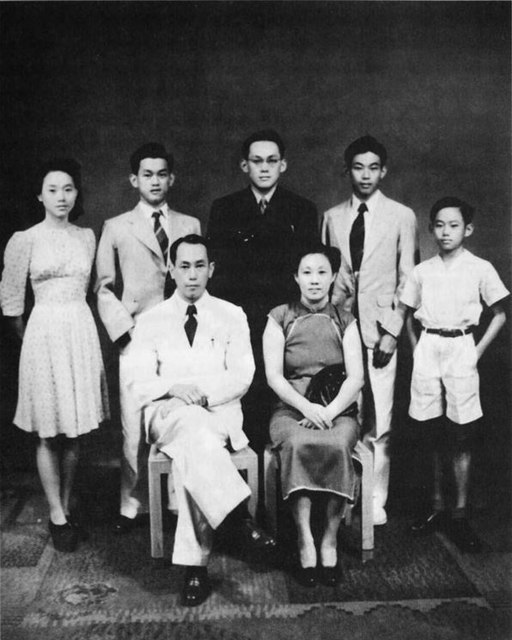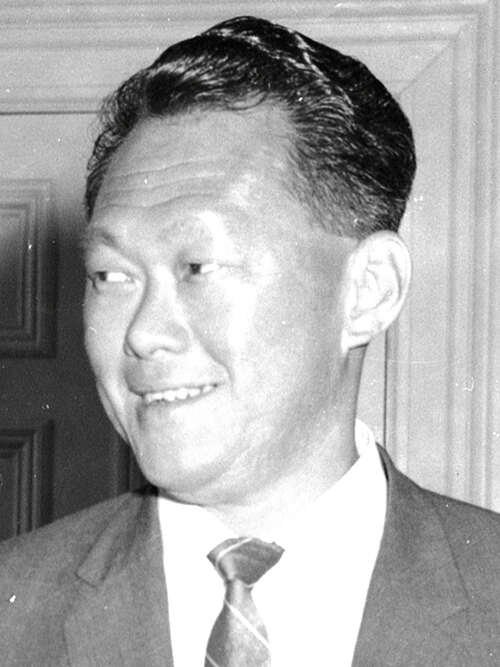The 100th Year of Lee Kuan Yew: Singapore Celebrates
The founding father of modern Singapore would have turned 100 last month, prompting various events. Who is this Lee Kuan Yew with an extraordinary destiny who made a small, destitute and divided island into a strong country on the international scene?
Lee Kuan Yew was a leader from Singapore. He was born on September 16, 1923, and passed away on March 23, 2015. He was the first prime minister of Singapore and is called the “father” of the country by some people. He led with strong control and followed a policy that favored the West.
A gifted boy from a wealthy family
Lee Kuan Yew was born on September 16, 1923 into a wealthy family of Chinese origin. His paternal grandfather was already born in Singapore. His paternal and maternal families prospered in commerce and were very affected by the crisis of 1929. This later encouraged Lee Kuan Yew to turn to a liberal profession, less dependent on the economic situation, in this case that of lawyer.

Lee as a child. See page for author, Public domain, via Wikimedia Commons
Always first in primary school without making much effort, he had to start working more seriously when he joined Raffles Institution, the elite college in Singapore where the best students in the country meet. He rose to first place, which earned him a scholarship to Raffles College, which has since been integrated into NUS (National University of Singapore). There he met the woman who would become his wife, Kwa Geok Choo, the only girl in the school, alternating first and second places with Lee Kuan Yew.

Lee family photo in 1946. Lee Kuan Yew is in the back row, centre. Family photo on the eve of Lee’s departure for the United Kingdom. The Singapore Story: Memoirs of Lee Kuan Yew, Public domain, via Wikimedia Commons
The impact of the Second World War
The war reached Singapore at the end of 1941 and the Japanese occupied the country in February 1942. The universities ceased to function and Lee Kuan Yew had to interrupt his studies. He narrowly escaped the roundups of Chinese who were exterminated by the thousands. This period was rich in learning for him. The debacle of the English led him to think that Singapore could only count on itself to build its future. The ferocity of the Japanese and the harshness of living conditions revealed the sometimes sordid aspects of human nature when it comes to survival. Lee Kuan Yew developed a deep aversion to violence.
To occupy his time, he learned Chinese, which he did not know well because his family was English-speaking. He worked for a time in the company of a family friend. Then he learned Japanese and worked for a few months for the occupiers as a translator of messages from English-speaking news agencies.
End of studies in England
When the war ended in 1945, he decided to finish his studies in England, rather than continuing at Raffles College. After a few adventures, he landed at Cambridge where he excelled again: he finished first in his class. There he found Kwa Geok Choo, whom he married in secret at the end of 1947. She, superiorly intelligent, would be the essential support to enable Lee Kun Yew to succeed in his political life: she took complete care of the home which would count three children, she served as his partner for debates that could hardly be put in the public arena, and, given her profession as a lawyer, she could ensure the survival of the family if her husband’s political projects, to which she actively participated, were to fail.
During his stay in England, Lee Kuan Yew was introduced to politics by participating in the electoral campaign of a Labor candidate. However, his first-hand knowledge of the English political world, more interested in the survival of their empire than in the future of the peoples who constituted it, finally convinced him that Singapore should take the path to independence. At the same time, he met regularly with members of a forum aimed at promoting the independence of Malaysia and Singapore.
Read also: Death Penalty and its Consequences | The Controversial Debate : Right or Wrong?

Lee’s barrister’s wig and container, on display in the National Museum of Singapore. Former Prime Minister of Singapore Lee Kuan Yew’s barrister’s wig and container (1949) from Ravenscroft, on display at an exhibition entitled In Memoriam: Lee Kuan Yew at the National Museum of Singapore between 25 March and 24 May 2015. Lee and his wife Kwa Geok Choo both purchased wigs when they were called to the Bar, but apparently only wore them for formal photographs and not in court. Smuconlaw, CC BY-SA 4.0, via Wikimedia Commons
From trade unionism to politics
On his return to Singapore in 1950, Lee Kuan Yew joined the law office of a progressive Englishman and participated in his election campaign for the legislative council. From 1952, to the great dismay of his employer, he became involved with numerous workers’ unions to defend their cause against the British establishment. In 1954, having changed offices, he successfully defended students accused of sedition for having written an article denouncing Western imperialism in the university’s internal newspaper. He thus gained his role as leader in the movement for emancipation from colonial supervision.
In the run-up to the 1955 elections to a more open legislature, Lee Kuan Yew brought together people of all races and stripes, including trade unionists and communists, to create a people’s party in favor of independence and a union between Malaysia and Singapore. Thus was born in 1954 the famous PAP (People’s Action Party) still in power today in Singapore. Lee Kuan Yew served as its general secretary almost continuously until 1992. The PAP won 3 of the 4 seats for which it fielded candidates, with the ruling Progressive Party winning only 4 of the 32 seats.
In the years that followed Lee Kuan Yew participated in the delegation that negotiated Singapore’s self-governing status in London, which took effect in 1959. That year, the PAP won 43 of the 51 seats in parliament, and on June 5, Lee Kuan Yew became the first Prime Minister of Singapore, a position he held for 31 years.
In 1963, Singapore gained its independence as part of the federation of Malaysia. For Lee Kuan Yew, this union with Malaysia, close geographically and culturally, had an economic logic, providing Singapore with a complement rich in natural resources. Unfortunately, fundamental differences led to a divorce two years later, much to Lee Kuan Yew’s sadness. Singapore became an independent state on August 9, 1965.
The champion of multi-culturality, meritocracy, and the fight against corruption
One of the reasons for this divorce was the privilege that Malaysia intended to give to the Malays who were the majority there. For his part, Lee Kuan Yew campaigned for a multicultural society, where all were equal regardless of their ethnic origins. This was especially important as the majority of Singapore’s population was and still is of Chinese origin. When Singapore left Malaysia, there were intercommunal conflicts in Singapore. Lee Kuan Yew then invested a lot to ensure harmony between the different communities. This took various aspects: for example, the establishment of four official languages, the establishment of quotas in buildings to prevent the formation of ghettos of this or that ethnic group, laws punishing racial or religious attacks, insurance that all communities are represented in all management bodies in the country. Maintaining this harmony is a long-term task that must be constantly renewed, because the temptations of social fractures are numerous.
Another hobbyhorse of Lee Kuan Yew, a corollary of this multiculturality, is meritocracy which gives everyone the chance to succeed regardless of their origin. One of the foundations is a very efficient education system accessible to all. This was also the way to promote Singapore’s only natural resource: its population.
One of the points on which Lee Kuan Yew has never compromised is that of zero tolerance towards corruption, a source of erosion of the efficiency of the economy, of the population’s confidence in the government, and of reputation of the country. This is one of the reasons why Singapore’s ministers are among the highest paid in the world. The white outfit of PAP members reflects this line of conduct.
A determined but pragmatic long-term policy
When Singapore became an independent state, few people thought highly of the future of this tiny, then developing country, without natural resources, periodically agitated by ethnic conflicts, often instigated by its neighbors.
Lee Kuan Yew quickly understood that salvation required foreign investments to give jobs to Singaporeans, the country’s only real wealth. In 1961, the EDB (Economic Development Board) was created, responsible for traveling the world to promote, with incentives, the merits of Singapore in the eyes of potential investors. This is how the country became, with Hong Kong, Taiwan and South Korea, one of the four Asian dragons, these countries which industrialized at high speed with a growth rate constantly above 7% between 1960 and 1980. The unemployment rate therefore remained low. The stability of the country and the increasing level of education has led more and more international companies to invest in Singapore and even set up their regional headquarters there. This movement was favored by tripartite agreements between unions, businesses, and government, which prevent social conflicts.
Satisfying the Singaporean population also meant providing them with decent housing. In the 1960s, the HDB (Housing & Development Board) was created to build simple but quality housing to replace the then unsanitary housing in Singapore. Today, nearly 80% of Singapore’s resident population lives in HDB housing and of these, 90% are homeowners.
One of Lee Kuan Yew’s long-term goals was to make Singapore a clean, green garden city, which contributed to the well-being of Singaporeans and the country’s attractiveness to foreign companies. . Another of his constant concerns was to ensure a sufficient water supply to the country.
Lee Kuan Yew was very curious about all the foreign experiences that could benefit Singapore. He did not hesitate to call on foreign experts to fill the country’s gaps, such as the Israelis to build the Singaporean army from scratch when the British suddenly withdrew their forces at the end of the 1970s. Furthermore, unlike many other countries, it did not strive to annihilate the work of the colonizers, but rather sought to make the most of it.
Finally, Lee Kuan Yew always remained humble despite his role. When he became Prime Minister, he preferred to stay in his modest house on Oxley Road, rather than live in the official residence which was his rightful property within the grounds of the Istana and he was far from having the highest salary in his office.
All this explains the success of Singapore and the longevity of the PAP (People’s Action Party).

Lee Kuan Yew and his wife Kwa Geok Choo with United States President Ronald Reagan and his wife Nancy Reagan on 8 October 1985 at the White House, on The North Portico Before a State Dinner. Series: Reagan White House Photographs, 1/20/1981 – 1/20/1989Collection: White House Photographic Collection, 1/20/1981 – 1/20/1989, Public domain, via Wikimedia Commons
A man who knew how to surround himself and withdraw
Singapore is not the product of a “one man show”. Lee Kuan Yew knew how to surround himself with talents he trusted and did not hesitate to change his mind when it was clearly demonstrated to him that there was objectively a better solution. But he was a tenacious debater and his interlocutors had to be well prepared. He was not stingy with his advice and gave it widely to those around him, not only to his immediate entourage, but also to his foreign visitors, who came in increasing numbers to understand the workings of the Singaporean “miracle”. He also wrote numerous books to explain his approach and his motivations.
Unlike many leaders from decolonization, Lee Kuan Yew was able to abandon his post as Prime Minister when he thought that Singapore was on the right track at the end of 1990. He had prepared his succession carefully to ensure that the next team would be made up of strong personalities continuing to work for the long-term good of the country. This gentle method of succession remains one of Singapore’s trademarks. Lee Kuan Yew nevertheless remained in the government in an advisory role until 2011.
His disappearance in March 2015 gave rise to an extraordinary display of national mourning: for several days, often in the rain, 1.7 million Singaporeans came to parade in front of his remains. Although not everyone approves of all his choices or methods, most Singaporeans, even those who suffered his wrath, recognize the crucial positive role he played in building their country.

People queueing outside Parliament House, Singapore, to pay respects to the late former Prime Minister of Singapore, Lee Kuan Yew, who lay in state there from 25 to 29 March 2015. Smuconlaw, CC BY-SA 4.0, via Wikimedia Commons
Sources: The New York Times, PinterPandai, Forbes
Photo credit: Wellington City Archives, CC BY-SA 4.0, via Wikimedia Commons.
Photo description: Mr. Lee Kuan Yew, Prime Minister of Singapore, at a Mayoral reception.



